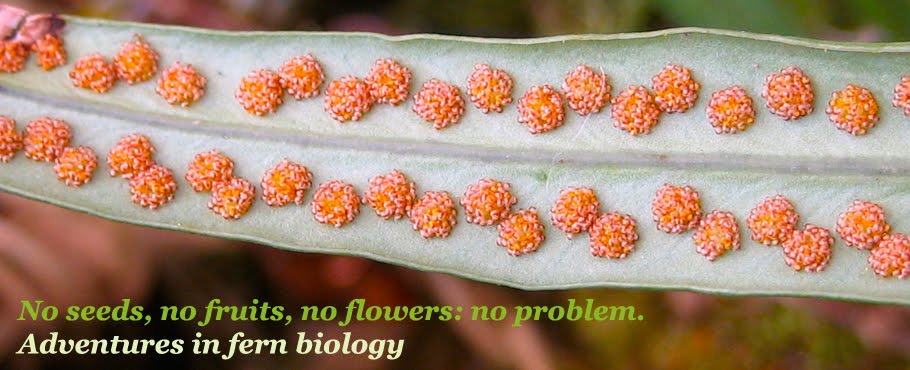Friday, May 30, 2008
Fern Pots
Wednesday, May 28, 2008
Botrychium virginianum
While in Ithaca I spent a great and productive morning at the Thurber Nature Preserve in McLean, New York, with my friend Robert Wesley of the Cornell Plantations. Robert knew exactly where to go for the ferns I was specifically interested in finding (several species of Dryopteris reside in the woods and swamp), and during the search we also came across some other interesting species, including this Botrychium virginianum. This is the largest individual of this species I've ever seen! They often don't get much larger than my palm, and this one was practically a salad plate! The common name for this group is the Grape Ferns, and this particular one is also known as Rattlesnake Fern. I don't think it takes much imagination to see where those names derive from... the fertile spike emerging amid the triangular sterile frond definitely appears to bear either grapes on a vine or maracas from those rattlin' tails, depending on how you view it. In fact, those green orbs are the sporangia.
Monday, May 19, 2008
Osmunda claytoniana
Saturday, May 10, 2008
Fern Craze
You may or may not have heard of the "Victorian Fern Craze," a time when ferns, fern gardens, and fern decorations were very popular throughout Great Britain. If you haven't heard of it, you're missing one of the more eccentric fixations of those wacky Victorians, and that's coming from a fern lover. Between roughly 1830 and 1890, the passion for ferns (or 'pteridomania' as it came to be known) reached its peak in England and Scotland, where gentlepeople arranged outings to collect ferns, which they then stored in ornate glass terrariums. These in- and outdoor fern gardens served as the inspiration for many ferny items, including the 'Fern and Blackberry' cast iron garden seat pictured above, manufactured by the English Coalbrookdale Company around 1870. I wouldn't mind something like that for my garden...
The top-left image, Gathering Ferns, is from the Illustrated London News, July 1, 1871, and the bell-cover at top-right is from the 1856 Rustic Adornments for Homes of Taste.
Wednesday, May 7, 2008
Polystichum
Saturday, May 3, 2008
Polypodium
Friday, May 2, 2008
Mauchline Fernware
Subscribe to:
Comments (Atom)
























